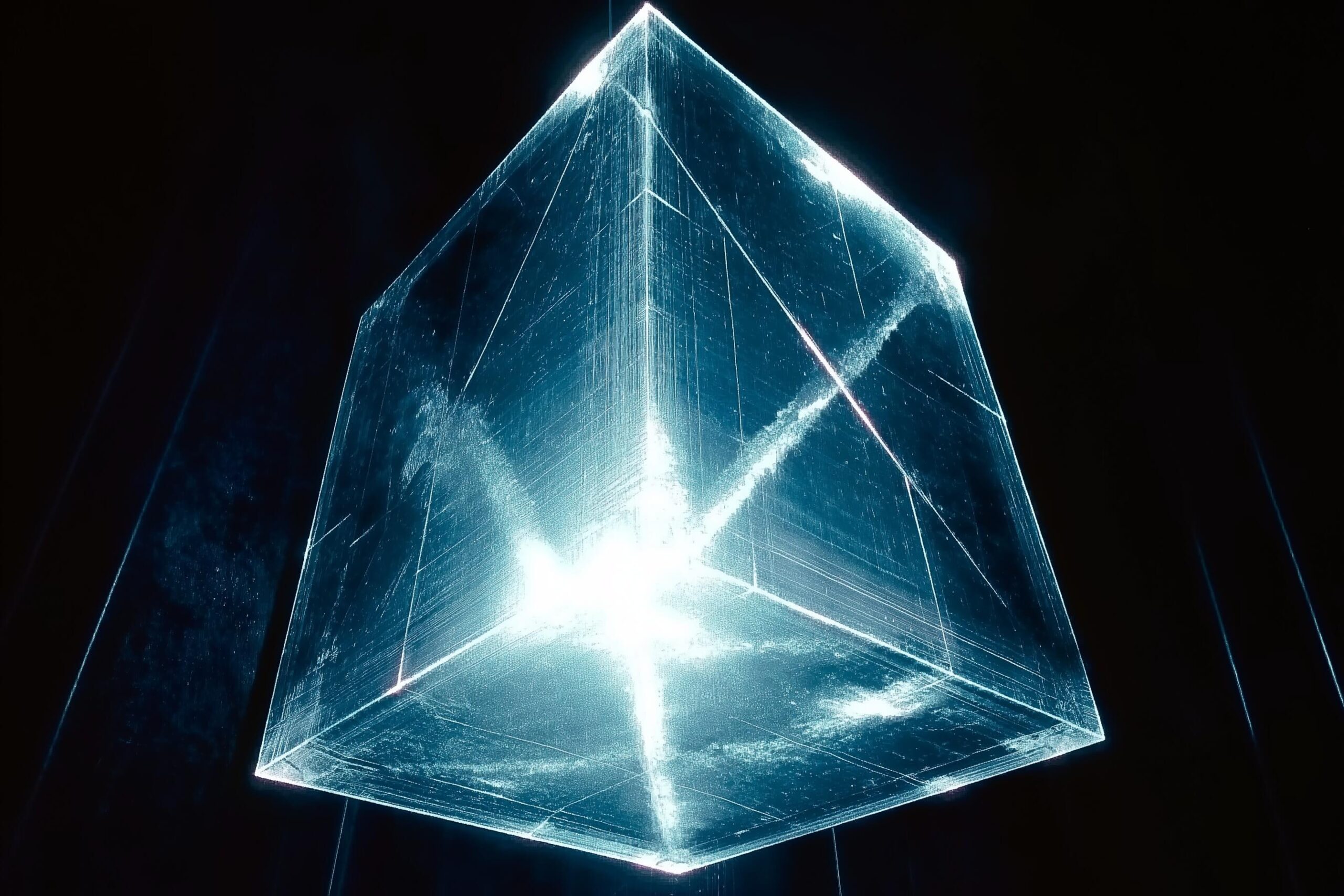Abstract
I present a conceptual design for the Q-Cube Gravity Antenna—a cube-shaped interferometric device engineered to detect high-frequency gravitational disturbances and to serve as a potential channel for interstellar communication. The Q-Cube is constructed from an ultra-stable artificial crystal and incorporates high-finesse optical cavities aligned along the X, Y, and Z axes. Precision lasers and superconducting detectors are integrated on each face to measure minute changes in optical path lengths caused by gravitational wave strains. In this paper, I develop the theoretical framework based on quadrupole radiation for gravitational wave generation, derive the relevant optical phase shifts with realistic enhancements from cavity finesse, and analyze the device’s sensitivity under practical noise constraints. I also discuss the scaling of the detector relative to source mass and frequency, compare it with existing large-scale detectors, and explore its speculative applications in monitoring engineered high-energy events—such as atomic explosions or warp drive activations—as well as in establishing a communication network between advanced civilizations. Although significant technological breakthroughs are required, the Q-Cube Gravity Antenna provides a detailed roadmap for future research in compact gravitational wave detection and gravitational communication.
1. Introduction
Gravitational wave detection has revolutionized astrophysics, with large-scale interferometers like LIGO and Virgo confirming theoretical predictions from general relativity. I propose the Q-Cube Gravity Antenna as a compact alternative designed to operate in high-frequency regimes and to potentially serve as a communication device among advanced civilizations. The device aims to detect microgravity waves produced by nonisotropic, high-energy events that generate a measurable change in the local spacetime metric. In this paper, I outline the theoretical principles, design components, and necessary technological advances to build the Q-Cube. I also present a detailed analysis of the measurement scheme, realistic noise considerations, and a discussion on the scaling of detector size with respect to source mass and gravitational wave frequency.
2. Theoretical Framework
2.1 Gravitational Wave Generation and Quadrupole Formalism
Gravitational waves (GWs) arise from time-varying mass quadrupole moments. For a source with quadrupole moment , the strain amplitude at a distance is approximately given by
where is the second time derivative of the quadrupole moment. This formulation highlights that the gravitational wave strength depends not solely on the total energy released but on the asymmetry and acceleration of the mass distribution. For isotropic events (such as a spherically symmetric nuclear explosion), the quadrupole moment is nearly zero, leading to negligible GW emission. Consequently, the Q-Cube is best suited for detecting events with pronounced mass acceleration asymmetries.
2.2 Interferometric Detection and Resonant Enhancement
In a laser interferometer, a gravitational wave alters a proper length by an amount
For light of wavelength , this length change produces a phase shift
By integrating the laser beam into a resonant optical cavity with finesse , the effective number of round trips is . The enhanced phase shift then becomes
For instance, with , , , and a target finesse , the phase shift would be approximately
This value, though extremely small, is in principle detectable provided that noise sources are sufficiently suppressed.
3. The Q-Cube Gravity Antenna: Structural and Component Design
3.1 Overall Structure
The Q-Cube is a cube-shaped structure with side length fabricated from an artificial crystal designed for ultra-low thermal expansion and high mechanical stability. Materials such as ultra-pure silicon carbide or sapphire, maintained at cryogenic temperatures, are ideal candidates. Active vibration isolation and precision mounting further ensure that environmental disturbances are minimized.
3.2 Optical Cavity Integration
Each of the six faces of the cube serves as a boundary for three independent optical cavities aligned along the X, Y, and Z axes:
- X-Axis Cavity: A laser emitter is mounted on the face, with a high-reflectivity mirror and detector on the face.
- Y-Axis Cavity: A similar arrangement is implemented on the and faces.
- Z-Axis Cavity: The remaining pair of faces is dedicated to the Z-axis measurement.
These cavities are designed with ultra-high finesse. Precision microfabrication techniques are employed to deposit and align mirrors with sub-wavelength accuracy. Active stabilization (using piezoelectric actuators) maintains the cavity resonance and compensates for any thermal drift.
3.3 Laser and Detector Systems
I use state-of-the-art ultra-stable diode lasers with extended coherence times, actively locked to a reference cavity to reduce frequency noise. The lasers are chosen for narrow linewidths and high phase stability. Detectors consist of superconducting nanowire single-photon detectors, coupled with quantum-limited amplification circuits, to achieve the timing resolution necessary for detecting phase shifts on the order of .
3.4 Electronics, Data Acquisition, and Control
A high-speed data acquisition system digitizes the signals from the photodetectors with attosecond-level time resolution. Real-time digital signal processing algorithms perform Fourier analysis and cross-correlation among the three axes to extract the gravitational wave signal from the noise. Active feedback loops continuously adjust laser frequencies and mirror positions to maintain optimal cavity resonance and alignment.
3.5 Assembly and Calibration
The fabrication process involves the following steps:
- Crystal Fabrication: Produce a monolithic cube with precise dimensions and minimal internal stress.
- Mirror Deposition: Integrate ultra-low-loss, high-reflectivity mirrors on the interior surfaces using advanced coating technologies.
- Laser and Detector Mounting: Precisely align lasers and detectors with the optical axes of the cube.
- Cavity Stabilization: Employ active control systems to lock the cavities at resonance.
- Calibration: Use known reference signals and environmental controls to establish a baseline phase and time-of-flight measurement.
4. Mathematical Analysis and Sensitivity Estimates
4.1 Time-of-Flight Variations
For a cavity arm of length , the nominal light travel time is
A gravitational wave producing a strain changes the arm length by
resulting in a time delay
For example, with and ,
This delay is amplified by the cavity finesse as described above.
4.2 Phase Shift Enhancement
The phase shift induced in the optical cavity is given by
Using the values , , , and ,
4.3 Noise Budget Considerations
The sensitivity of the Q-Cube is ultimately limited by several noise sources:
- Thermal (Brownian) Noise: Mechanical losses in the crystal and mirror coatings introduce displacement noise.
- Quantum Shot Noise: The inherent photon counting uncertainty contributes an uncertainty proportional to .
- Frequency and Laser Noise: Instabilities in laser frequency must be mitigated via active stabilization.
- Seismic and Environmental Noise: Although the device is vibration isolated, residual noise must be modeled and subtracted.
A comprehensive noise budget suggests that to detect phase shifts on the order of , the combined noise must be reduced below this threshold. Techniques such as quantum squeezing may be employed to overcome the standard quantum limit.
5. Applications and Scaling
5.1 Detection of Engineered and Astrophysical Events
The Q-Cube Gravity Antenna is designed to detect gravitational disturbances from both astrophysical and engineered sources. For example:
- Atomic Bomb Explosions: A nonisotropic, high-energy event may produce a transient quadrupole moment, leading to a measurable signal.
- Hypothetical Warp Drive Pulses: Although speculative, any significant spacetime distortion due to exotic propulsion might be detectable.
- Astrophysical Phenomena: Events such as black hole mergers produce low-frequency waves; however, the Q-Cube is optimized for higher-frequency disturbances, potentially generated by smaller-scale astrophysical events.
5.2 Interstellar Gravitational Communication
I propose that advanced civilizations could use gravitational wave modulation as a communication channel. By deliberately modulating high-energy events (within safe limits), it may be possible to imprint information on the gravitational signal. The Q-Cube, with its multi-axis configuration, could detect such modulations and serve as a node in an interstellar communication network. I acknowledge that generating detectable gravitational waves typically requires enormous energy; therefore, this application remains highly speculative and would necessitate breakthroughs in both energy production and wave modulation.
5.3 Scaling with Source Mass
The sensitivity and required size of the Q-Cube are functions of the strain amplitude , which scales as
For more massive or closer sources, is higher, and a smaller Q-Cube may suffice. For weaker signals, a larger detector or a network of Q-Cubes would be necessary to integrate and correlate the signal.
6. Discussion
The Q-Cube Gravity Antenna integrates established principles from laser interferometry with advanced concepts in material science and quantum metrology. I recognize that many of the technical requirements—such as achieving ultra-high finesse () in a compact, cryogenically cooled crystal, and attaining laser phase stability at the level required to detect phase shifts on the order of —are beyond current capabilities. Nonetheless, incremental advances in nanofabrication, laser stabilization, and quantum noise reduction techniques could pave the way for such devices.
This work distinguishes between the rigorous treatment of gravitational wave detection (based on quadrupole radiation and realistic noise models) and the speculative applications of gravitational wave communication. While the detection of astrophysical signals is firmly rooted in established physics, using gravitational waves as a communication medium remains a visionary concept requiring energy scales and modulation methods that are not yet available.
7. Conclusion
I have detailed the conceptual blueprint for the Q-Cube Gravity Antenna, a compact interferometric detector designed to measure microgravity waves and to serve, potentially, as a component of an interstellar gravitational communication network. The design leverages a cube-shaped artificial crystal integrated with high-finesse optical cavities along the X, Y, and Z axes, precision lasers, and superconducting detectors to measure minute phase shifts induced by gravitational strains. I have provided a rigorous theoretical framework that incorporates the quadrupole formalism for gravitational wave generation, realistic enhancements via resonant cavities, and a detailed noise budget. Furthermore, I discuss the scaling considerations for different source masses and frequencies, and I critically assess both the established and speculative applications of the device. While many technological challenges remain—particularly in materials, laser stability, and quantum noise suppression—the Q-Cube Gravity Antenna offers a detailed roadmap for future research in compact gravitational wave detection and may ultimately open new avenues for interstellar communication.






